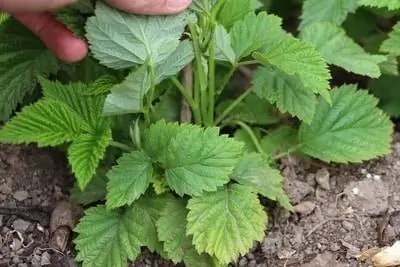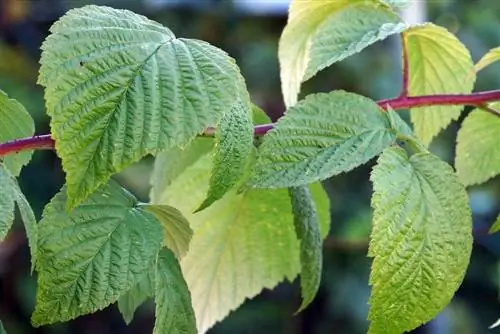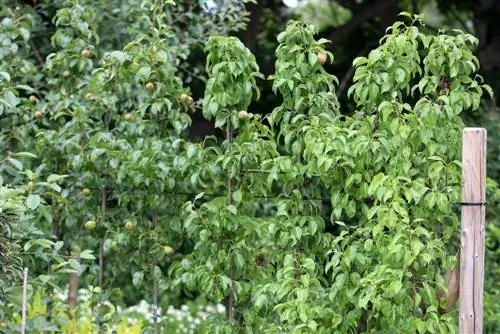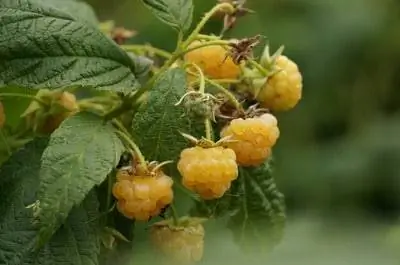- Author admin [email protected].
- Public 2023-12-17 03:39.
- Last modified 2025-06-01 06:48.
Planting a raspberry is one of the simpler tasks in this world (“soil up, raspberries in, soil closed”), and yet there are a lot of details to consider if the result is to be truly satisfactory. To satisfy you as a gardener, the raspberries will grow even if you leave out one or two things. Only you will be annoyed for many years if the raspberries, for example, B. are so close that no harvest is possible without wounds or were planted too far apart without necessity, so that valuable garden space was wasted
The ready-to-plant raspberry
When you buy the raspberry plants, you will usually receive them ready to plant, which should look something like this:
- The optimum would be bales, grown in soil similar to that at the planting site and just “harvested”
- Rarely available, perhaps in organic gardening, otherwise from gardening enthusiasts
- Bare root raspberry plants are sold with roots without soil in a box
- The roots should be protected from drying out with moist straw or similar
- Bare root products can only be planted for a few weeks in spring and autumn
- No longer completely fresh, it takes a long time to grow and has a higher failure rate than bale or container goods
- This raspberry was allowed to develop outdoors into a robust plant with he althy roots
- Container raspberries are sold in pots and have also been grown in pots
- They are allowed to put down just enough roots so that they can stand upright and take care of themselves
- “An extra root” to increase resistance is usually no longer possible
- Hasty careless container plant production produces plants with root damage such as twisting growth
- For container plants, make sure you get fresh raspberries with large root balls
- After purchase, the plants can stay in the opened sales container for a few days in cool weather
- Then be sure to keep the roots moist all around and throughout
Tip:
Cultivated raspberries are very susceptible to viral diseases. Therefore, before purchasing, you should: For example, you can ask the local environmental agency whether a certain raspberry virus is currently in abundance in your area and request annual, guaranteed virus-free specimens from the nursery. To ensure that they remain virus-free, you should choose cultivars that are known for good he alth and resistance and are resistant to many pathogens. The summer raspberry 'Rubaca' is e.g. B. such a breeding variety: He althy growing, extremely high resistance to Phytophthora root dieback, insensitive to cane dieback, other root diseases and botrytis (or you can plant the original, resilient wild raspberries, see next tip).
The best time to plant
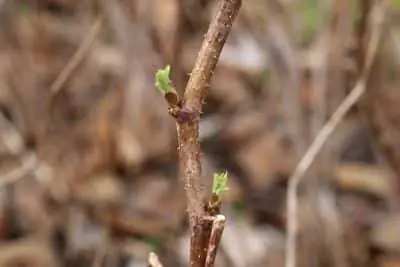
The best time for planting is late autumn, because the raspberry can then establish itself in peace over the winter before plant growth above the ground is required in spring (which can now start in full force after the “productive winter rest”.). For normal to friendly regions of Germany, late autumn means October to mid-December. In harsh areas with an early risk of frost, raspberries should be planted in the ground in October to be on the safe side (growing raspberries is not recommended in harsh areas with many late frosts).
Bare root raspberries/balled goods can also be planted in spring when they have been freshly harvested and it is not too hot yet; In principle, container goods can be placed in the ground all year round, provided that the weather is frost-free and the ground is not frozen. However, planting in autumn has also proven to be useful for container raspberries, because a full harvest in the following season is more satisfying than the “five raspberries”, which (if planted very early in spring) can still be harvested in the planting season.
The best weather for planting is cloudy and gray because freshly planted plants come under supply stress when they have to transport a lot of water to the leaves in warm weather.
Location, Soil & Preparation
In the wild, raspberries grow in or on the edge of the plant community called “undergrowth” in the forest. In good soil, in the protective lee of taller trees, in light, but rarely “bothered” by bright sun. The closer the garden location is to the natural location, the better the raspberry plant will be able to develop its natural growth habit. The closer a plant comes to natural growth, the better and, above all, he althier it will grow. Means in detail:
- Bright, semi-shady to sunny location
- Without burning midday sun
- ideally shaded by a taller tree, especially at midday
- It also protects the raspberry plants from strong winds
The soil at the location should be as close as possible to a forest floor, so it must have certain qualities:
- Evenly moist
- But well drained
- Humus-rich and nutrient-rich
- Happy to bring lots of clay
- Deep, i.e. rich in organic matter even under the top layer of soil
- Raspberries prefer slightly acidic soils with pH values between 5.5 - 6.5
- The soil can be prepared months in advance for the raspberries
- Excavate soil at the planned location
- Usually “spade-deep excavation” is recommended
- You should judge whether this is enough after reading the section about the raspberry roots
- If there is compacted soil underneath the excavation, loosen it by piercing or tearing open the bottom of the planting hole
- Rake up the excavation loosely with the coarse rake until no more lumps are noticeable
- Mix soil generously with well-rotted compost
- In calcareous soils, it should contain acidifying components such as plant parts of softwoods or a lot of coffee grounds
- The raspberries also like to accept a little stone powder, i.e. an extra portion of minerals and trace elements
- Refill the excavated soil

Tip:
If, despite good efforts to improve it, the soil in the planned location still resembles dry sandy soil or is still too calcareous, you can still plant raspberries in this soil. In order to be successful with raspberry cultivation, you then have to compensate for the soil deficiencies through care, i.e. sufficiently irrigate soils that are too dry and reduce excessive lime content using acidifying mulches. If the location is also rather dark, you should probably plant wild raspberries. They can cope with little light and almost all garden soils and may not produce a huge harvest, but one with a real, unique raspberry aroma.
Raspberries and their roots
Raspberries, as shallow-rooted plants, should draw their water and nutrients from the top layer of soil, but should be planted in deep soil. It is even recommended to cultivate them on earth banks so that the roots do not reach soil depths where they are exposed to waterlogging; a rather bizarre set of instructions, because thoroughly loosening the top layer of soil is certainly quicker and easier to accomplish than building a loose earth bank that is stable enough for roots to penetrate.
In any case, these instructions given in common raspberry cultivation instructions do not fit together, something that the raspberry growers in the Langförden raspberry growing region in Lower Saxony noticed around 1.5 decades ago. In 2002, they took a closer look at how raspberry plants distribute their roots in the soil, on a whole series of plants that grew at large distances.
Result: Around 80% of the roots actually grew in the top 20 cm and often absorbed nutrients and water just a few millimeters below the soil surface. In this dense network of fine suction roots, the inquisitive raspberry professionals also found a few thicker horizontal strands, as expected, with sprouting eyes that produce the young rods to renew the tree in spring.
Note
Whatever they found - surprisingly - were one or two strong, thumb-thick roots that grew vertically downwards (not to be explained by any special need at the location, Langförden also became a raspberry growing area because of the high groundwater level). These roots could be traced to 80 cm and deeper, used old root canals from previous plantings and earthworm tubes; they were obviously intended to secure the water supply in the event of prolonged drought. With the discovery of these roots, raspberry growers now understood why their raspberries continued to grow happily when sugar beet and strawberry fields "slacked off" due to drought and had to be irrigated.
The result confirms the growing number of home gardeners who are concerned about soil care and the establishment of soil-working microorganisms: It is obviously worthwhile to keep the garden soil loose and rootable down to the depths. In the light of this study, home gardeners who already have such soil could definitely check whether their raspberries are self-sufficient in dry times instead of immediately reaching for the sprinkler when the sun has shone for three days in a row.
Space requirements and neighborhood
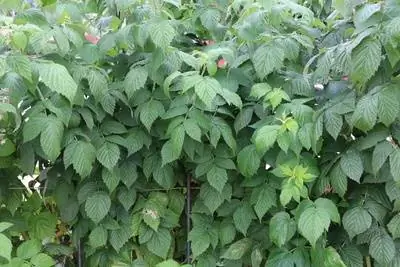
Raspberries cause soil fatigue, which can be caused by nematodes, harmful fungi, one-sided consumption of trace elements and other reasons. Without a soil disinfection program (this is how soil fatigue is combated in professional plant production; a highly difficult matter if the entire soil life is not to be killed) or soil exchange (to a depth of approx. 1 m cubic meters) the soil becomes lively again, if he doesn't feed on raspberries for a few years; New raspberries should never be placed where old raspberries were.
In the rest of the garden you need the following areas for the raspberries:
- Row planting: 40 to 60 cm distance between plants recommended
- Distance from row to row: 1.20 to 1.60 m
- 1, 60 m when the row spaces are entered for tending and harvesting
- This already compacts the soil to such an extent that roots are at risk of becoming waterlogged
- Logically always the case with more than two rows
- That's why a two-row extension that can be accessed from the outside is recommended
- The correct planting distance is important so that all parts of the plant get enough light
- It also allows the plant to have a loose growth habit with good ventilation, the best prevention against fungal infestation
- Alternative to row planting: raspberries on the garden fence, which then serves as a support
- In gardens without neat “box beds”, raspberries can be planted individually between other plants
- In addition to the raspberries, e.g. E.g. ferns, lily of the valley, tansy, marigolds, sharps or forget-me-nots grow
- All of these plants are known to promote the he alth of raspberry plants
- Among the crop plants, bush beans, small peas, garlic, lemon balm and onions should grow in a promoting symbiosis with raspberries
- The raspberry also ensures optimal pollination for these (and itself):
- The flowers are a pasture for bees and butterflies at the same time, honey and wild bees and 54 species of butterflies are attracted
- This could increase the harvest of raspberries: as has recently been researched, the yield of crops increases with the number of species that pollinate these plants
Pruning required?
Raspberries ordered by mail order are almost always cut ready for planting. Even in nurseries that sell to hobby gardeners, you usually no longer have to worry about pruning; if then with precise instructions such as “cut the raspberries back by a third in the upper area after planting”.
Raspberries from non-professional sources, on the other hand, are usually available “as grown”. In order for these raspberries to grow well, they must be prepared for rooting using a so-called planting cut. The aim is to free the roots from too much plant mass above the ground so that they can concentrate fully on growing. If the raspberries have previously been allowed to grow freely “around the top”, the shoots should be shortened by one to two thirds after planting, depending on their vigor.
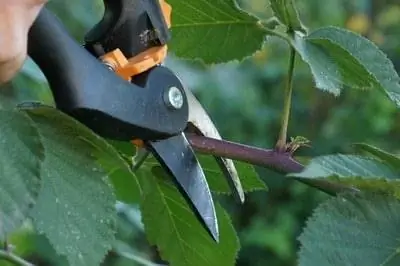
The root itself is examined carefully again before planting; broken or otherwise damaged roots are cut back to the intact root part.
Planting raspberries correctly
Now the raspberries can finally go into the ground, no big hassle after correct preparation:
- Soak root ball for 15 minutes before planting
- Then carefully loosen up a little, making sure not to reach too deep into the middle (but “brutal” tearing of the root ball is also recommended)
- Dig a planting hole, at least 20% wider and deeper than the root ball
- If the soil has not been prepared, briefly check whether the raspberry can root in loose soil all around
- If this is not the case, dig a slightly larger planting hole in the compacted area and loosen the excavation
- If the soil has not yet been enriched with compost, add half-rotted compost to the bottom of the planting hole
- Place a plant about the same height as in the nursery
- You can tell where it was in the ground by the color of the bark
- The eyes (buds) on the root ball should be covered by a 5 cm layer of soil
- Do not damage these when planting, they produce the “fruit after next”
- Fill in the soil again and press it lightly all around
- On dry/sloping terrain, pile up the watering edge so that irrigation and rain water collects around the roots
- Water the raspberries thoroughly all over
- Mulch the soil under the raspberries to a height of at least 5 cm about 1 m wide
- Suitable material: green waste, mixed with compost (with leaves from coniferous or deciduous trees), bark humus, straw
Depending on the cultivar (for more on its origins and selection, see “Fertilizing raspberries correctly”), the raspberries need support (more on this in “Raspberry bush care - planting and cutting”), and sometimes a little, depending on the soil fertilizer ora little watering depending on the weather; But actually that's it and you can soon enjoy delicious raspberries.

